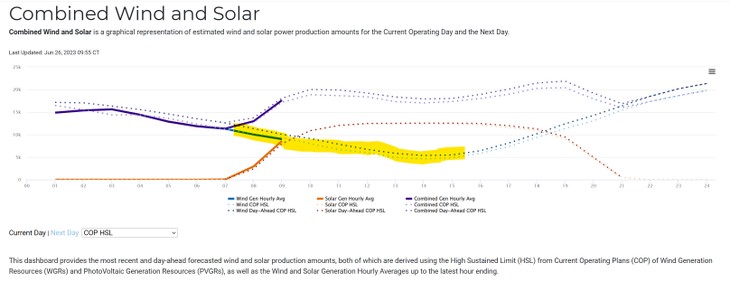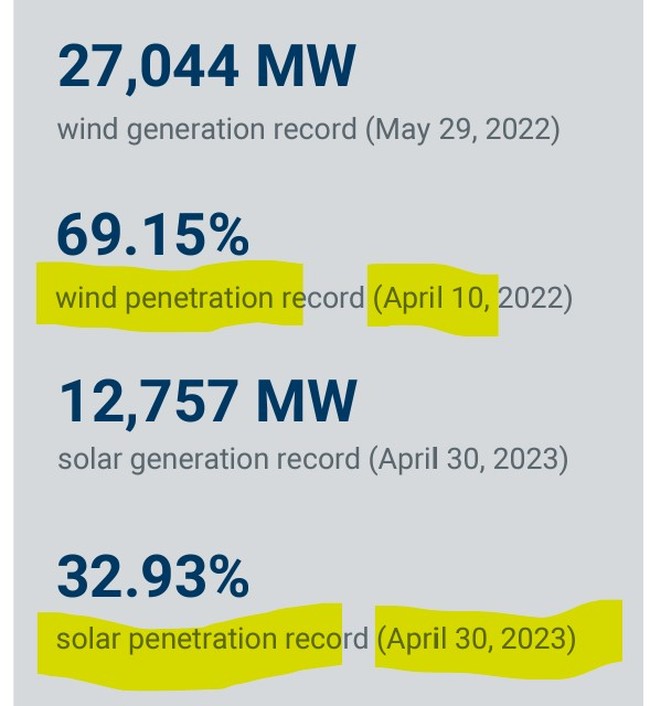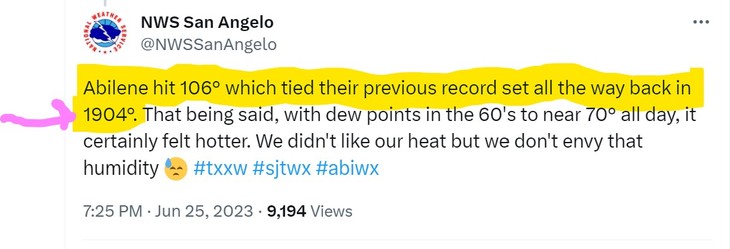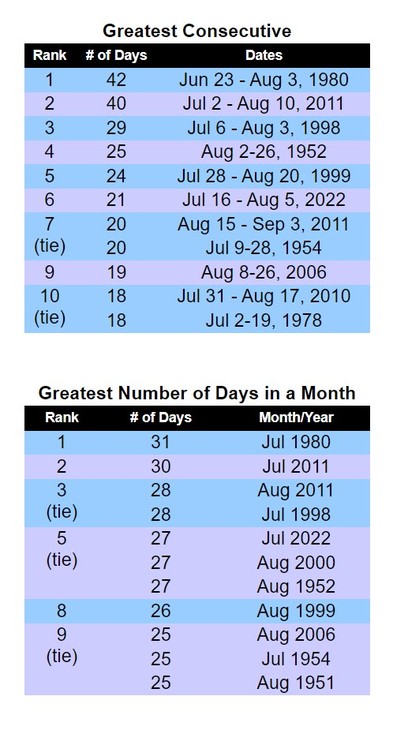Hot days in Texas? In the summer?
A couple things got me to musing on this phenomena of “summer heat.” One was the fact that what ever happens in Texas usually heads our way a day or two later. I used to call my Daddy’s weather reports from Cleburne (just south of Dallas) our forecast – invariably what he was seeing out his window we’d get. So the heat wave they’re experiencing is due over us here in Pensacola mid-week.
I hate summer with a passion – always have.
The other thing was an article I’d put in our headlines here this weekend “Texas poised to become solar energy leader amid power grid strain.” All this solar already online with more on the way, and ERCOT (Electric Reliability Council of Texas) is already begging people to conserve power?
Texas, known as the nation’s leader in oil production, is rapidly transforming into a front-runner in solar energy as well. The state has witnessed a remarkable growth in solar power generation, with the amount of solar energy produced doubling since the beginning of last year.
Projections indicate that this upward trajectory will continue, with solar power generation set to double once again by the end of next year. This surge in renewable energy comes at a critical time as Texas faces an escalating demand for electricity, prompting calls for energy conservation.
“[The Electric Reliability Council of Texas] (ERCOT) requests Texans to voluntarily conserve power during specific conservation period, if safe to do so,” ERCOT wrote on its website. “ERCOT requests all government agencies (including city and county offices) to implement any and all programs to reduce energy use at their facilities.”
In fact, they’ve issued what they call a “Weather Watch” THROUGH FRIDAY.
The Texas power grid operator issued a weather watch that will be in effect through at least Friday.
The Electric Reliability Council of Texas issues a watch when there is high demand for electricity.
Why are Texans living like they’re a third world country/California when they have all these wonderful, save-the-planet renewables on top of being fossil-fuel central?
I’m also curious what steps ERCOT takes to keep their solar panels humming when the temps run upwards of 100°+. That’s well above what the temps were when Britain’s solar arrays completely melted down on them a couple of weeks ago. As I learned doing the research for that post, solar doesn’t do so well when the sun is really shining.
…Why Don’t Solar Panels Work as Well in Heat Waves?
Solar panels don’t work well in heat waves due to the temperature-induced decrease in efficiency. As the temperature of the solar panels rises, their power output decreases. During a heat wave, the higher temperatures hinder the panels’ ability to convert sunlight into electricity effectively.
For the record, wind drops off markedly as well. If it’s really, REALLY hot, chances are there’s nothing blowing, and the ERCOT production prediction charts acknowledge that daylight decline.

I dug into ERCOT generation records a little, too to see when they’d had their best renewables days, as they were proud enough to list them in their info materials.

Now, I realize this is a state-wide compilation of energy production, so I just picked the weather in Dallas as a mid-point for solar that day to see what general sort of conditions was optimum.
The solar generation record was set on the 30th of April this year. I believe the penetration figure refers to how much of the power in the grid in toto was provided by solar, and that was almost 33%, on a beautiful, sunny 77° day.
Oddly enough, per what we’ve learned about solar panel efficiency, that is the perfect chef’s kiss day for them.
…As the temperature rises, the output voltage of a solar panel decreases, leading to reduced power generation. For every degree Celsius above 25°C (77°F), a solar panel’s efficiency typically declines by 0.3% to 0.5%.
Most of the wind farms are in the western half of the state, so I just landed on Lubbock, where the wind speeds on 29 May 2022 were humming in the 40mph range, with gusts almost to 50mph. Yeah, I’ll bet those turbines were whirling, even with it in the low 90s.
This week, when you need them most, the conditions aren’t sweet as pie for either renewable choice, and people are being told to conserve. Big fat help there, no?
No. Because the more renewables you bring into the system, the more unstable the system itself becomes trying to pick-up when they fall-off and switching between sources. It also makes it difficult when you are shutting down your reliable fossil fuel plants before you have the capacity online to handle both the renewables you’ve committed to and all the people moving to your state who also demand things like lights at night and air-conditioning in the summer. One also has to ensure that the natural gas one is betting the farm on to pick up the slack is operating at 100% efficiency throughout its cycles, and Texas has a real problem on their hands with that. One glitch, one switch, one freeze, or shutdown for emergency maintenance and they could be in a disaster again.
…Most troubling is that Texas still has difficulties in delivering natural gas during the coldest weather. When temperatures drop, we crank up our gas-fired furnaces and use a lot of electricity. We need a lot of natural gas to stay warm. When we can’t get it, Texans can die.
Which is what happened in February 2021, after a large number of gas processing plants seized up and shut down because of icy weather. Over a five-day period that month, the state’s gas processing capacity fell by 84 percent. Without those facilities treating the gas as it comes out of wells, gas can’t reach the state’s pipelines. This past December, the system’s performance was better, but still not great.
Over a two-day period in the run-up to Christmas, the state’s gas processing capacity fell 34 percent, according to Wood Mackenzie, an energy data and analytics firm. Still, “the fact that it was as cold as it was and we still had ample supply is a positive,” said Ben Chu, the firm’s head of trading analytics.
It also doesn’t help that people in the renewables cult are flat-out lying and saying “this has never happened before” in a persistent, malicious effort to drive ever more Green insanity on people.
…Yet, in spite of the sun-powered boost, analysts say the state’s electric grid remains unprepared for a warming climate where intense heat waves will become more frequent and severe.
The last few days have offered a preview of this hotter future. The current heat wave has shattered temperature records in many cities and reached as high as 118 degrees Fahrenheit along the Mexican border. The broiling conditions are expected to continue this week.
“We learned that climate change isn’t messing around,” said Alison Silverstein, a Texas-based energy consultant who authored a high-profile Department of Energy report on the reliability of the country’s electric system in 2018.
“This kind of heat dome and long-lasting extreme heat conditions are not anything we have seen before in Texas, and yet they are happening more and more often,”
Silverstein added. “We cannot change our built infrastructure fast enough.”
WHAT. LIES.
“Shattered” is rather dramatic for cities that have tied or beaten old records by a single degree, and they are by no means the majority, although many came close. I found one – count it, one – 30 year old record that took a 7° thumping. That’s something to talk about. Everyone else was just blistering hot. Ridiculous hyperbole.
If people would just take a deep breath and THINK – you can’t have “record-breaking” heat, unless? There were already previous records to be broken.

1904 – 119 years it took to get that hot AGAIN. Not “broken.” Just again. And those people in that 1904 cowtown did not have ERCOT to blame for the a/c and lights going out, nor diesel, plastic grocery bags, straws, or natural gas for destroying the planet.
Although they did have plenty of cow farts in the streets of Abilene, I will grant them that..
NOT ANYTHING WE HAVE SEEN BEFORE IN TEXAS?!
…But have you ever wondered: What was the hottest temperature ever recorded in Texas?
The hottest maximum temperature ever recorded in Texas occurred twice: First on August 12, 1936, in Seymour, northwest of Dallas, and again on June 28, 1994, in Monahans, a city near Odessa, according to the National Oceanic and Atmospheric Administration. The recorded high that day was 120° — that’s hotter than the 113° August average for Furnace Creek in Death Valley.
Even though 120° is hot as heck, it’s still nowhere near as hot as the highest recorded in the U.S. — that record belongs to Greenland Ranch, California, where the temperature hit 134° back on July 10, 1913.
This is the National Weather Service historical data just for the Dallas/Ft Worth area of greatest consecutive and monthly total of? 100°+ days.

1980 had to be a miserable year, but I’m assuming there’s no one left alive in the climate change cult who lived in Texas to remember it.
Because according to their current narrative, this is all new.
As for the rest of us, it’s summer, pretty damn warm already, and I sure hope they can keep all y’all’s Gaia murdering air-conditioning on.








Join the conversation as a VIP Member